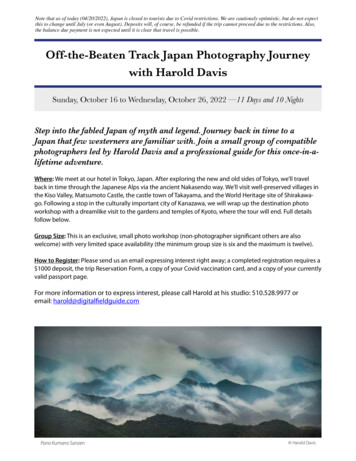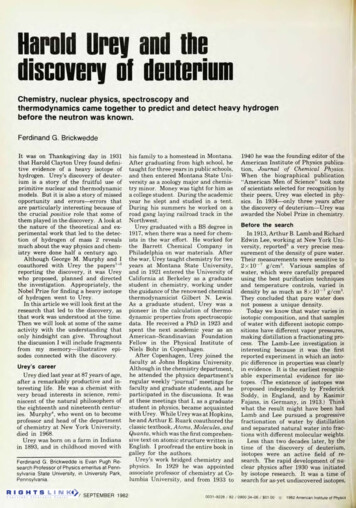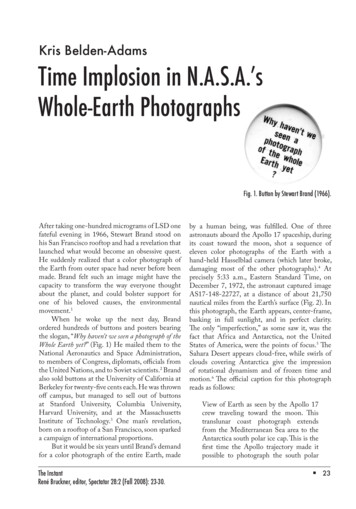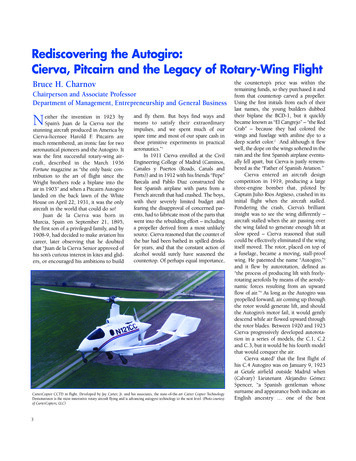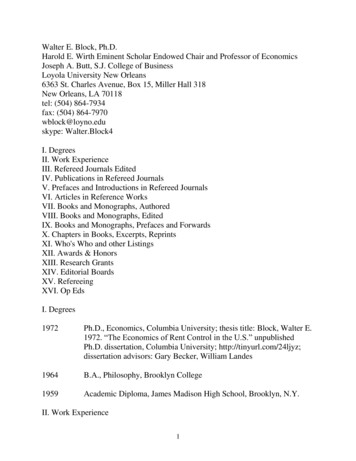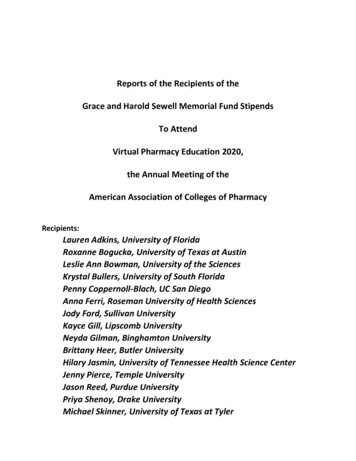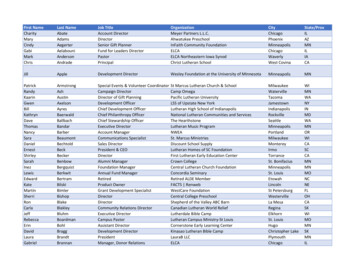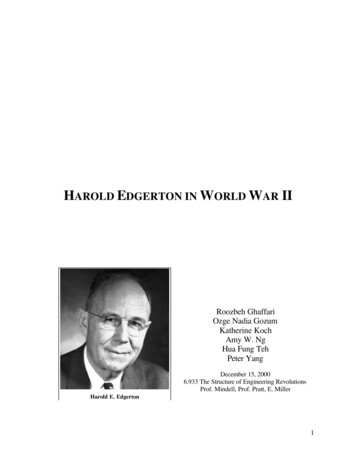
Transcription
HAROLD EDGERTON IN W ORLD WAR IIRoozbeh GhaffariOzge Nadia GozumKatherine KochAmy W. NgHua Fung TehPeter YangDecember 15, 20006.933 The Structure of Engineering RevolutionsProf. Mindell, Prof. Pratt, E. MillerHarold E. Edgerton1
HAROLD EDGERTON IN WORLD WAR IIINTRODUCTION 4PRE-WORLD WAR II 6THE BASIC S TROBE CIRCUIT 6PRE-WAR A PPLICATIONS OF THE S TROBOSCOPE AND EDGERTON’S WORK AT MIT 8EDGERTON’S COGNITIVE S TYLE 10WORLD WAR II 13WORLD WAR II CHANGES RESEARCH AT MIT 14AERIAL RECONNAISSANCE PHOTOGRAPHY 14W ORLD W AR I A ERIAL PHOTOGRAPHY 14FLASH BOMB 15EDGERTON JOINS THE WAR EFFORT 16DEVELOPMENT OF ELECTRONIC FLASH FOR NIGHT AERIAL RECONNAISSANCE 16SYSTEM DESIGN 17THEORY FOR FLASH LIGHT SOURCES 19TECHNICAL ISSUES 20THE S IX ELECTRONIC FLASH M ODELS 22BROADENING OF APPLICATIONS OF S TROBE TECHNOLOGY 26BALLISTIC TESTING 27A IRCRAFT BEACONS 28EDGERTON’S WORKING S TYLE DURING THE WAR 30CONDUCTING RESEARCH 30PRESENTING HIS W ORK 32INTERACTION WITH PEOPLE 35POST-WAR 36EDGERTON, G ERMESHAUSEN, & G RIER, INC. 37EG&G BEGINNINGSEG&G AND W ORLD W AR IITHE RAYTHEON CONNECTIONFORMATION OF EG&G, INC.EG&G TODAYINFLUENCE ON EDGERTON’S W ORK373838384040CONCLUSION 40WAR’S INFLUENCE IS COMPLEXCHANGE OF WORK ENVIRONMENTINCREASE IN S CALE AND M AGNITUDEBROADENING OF APPLICATIONSNEW AREAS OF RESEARCHA KEY FORCE IN EDGERTON’S LIFE404041414141HOW WE CONDUCTED THE RESEARCH 42ACKNOWLEDGEMENTS 42APPENDIX A: TIMELINE 432
LIST OF FIGURESFigure 1: Shooting the Apple. 4Figure 2: A Milk Drop. 4Figure 3: Edgerton Observing a Motor with a Strobe. 5Figure 4: Doc in the MIT Strobe Lab. 5Figure 5: Basic Electronic Strobe Circuit. 7Figure 6: Karl Compton. 8Figure 7: The Thread Machine. 9Figure 8: The Strobotac. 9Figure 9: Smoke through a Fan. 10Figure 10: Edgerton's Date Book . 11Figure 11: A Page from One of Edgerton's Notebooks. 12Figure 12: Boston Garden Track Meet . 12Figure 13: Joe Louis Vs. Arturo Godoy. 13Figure 14: MIT Exhibit at New York World's Fair. 13Figure 15: First Aerial Night Photo, Taken over Rochester, NY. 15Figure 16: Flash Bombs Being Loaded. 15Figure 17: Major Goddard. 16Figure 18: A Pre-War Kodatron Flash Unit. 17Figure 19: A D-3 Flash Unit. 17Figure 20: High-Level Circuit Design for D-2 Flash. 18Figure 21: Placement of a Flash Unit in a Plane. 19Figure 22: The Inverse Square Brightness Law. 19Figure 23: Condenser Banks. 20Figure 24: Photos Taken with Flash Bomb (left) and Electronic Flash (right). 21Figure 25: Timeline for Electronic Flash Development. 22Figure 26: The Milk Drop (left) and Stonehenge (right). 23Figure 27: Energy per Flash for Strobe Systems up to 1943. 23Figure 28: A D-3 Flash Unit in A-26. 24Figure 29: Flash Units Before Installation. 24Figure 30: Destroyed Bridge in Burma. 26Figure 31: Aerial Night Photograph of Normandy, June 6, 1944. 26Figure 32: Photo from Ballistics Test Using Sound Trigger -- Aberdeen, VA November 10, 1943. 27Figure 33: High-Speed Photographs of Explosion of 500 lb. Bomb. 28Figure 34: Edgerton’s Innovative Design for Aircraft Landing Beacons. 29Figure 35: Letter to Herb Grier . 30Figure 36: Lab Set up for Gun Shots . 31Figure 37: MIT from above. 32Figure 38: Stonehenge Night Photographs. From the Ground, Illuminated from Above (left) and an Aerial View(right). 33Figure 39: Flash Type D-2. 33Figure 40: Aerial Electronic Flash Control Unit. 34Figure 41: D2 Flash Unit in an A-20 Plane Described. 35Figure 42: Edgerton on the field - Britain. 35Figure 43: An Edgerton Lecture. 36Figure 44: An Atomic Bomb Explosion. 37Figure 45: Edgerton, Grier, and Germeshausen. 37Figure 46: Wartime Network: Los Alamos, Raytheon, and Edgerton . 38Figure 47: Grier, Edgerton, and Germeshausen. 39LIST OF TABLESTable 1: Comparison of Flash Bomb and Electronic Flash. 21Table 2: Specifications of Three Major Edgerton Flash Units . 24Table 3: Specifications of Edgerton Flash Units Modified from D-2. 25Table 4: Types of Planes and Flash Units They Could Carry. 253
H AROLD E DGERTON IN WORLD WAR IIINTRODUCTIONApproximately twelve years before Hitler invaded Poland and World War II erupted, Harold“Doc” Edgerton, an avid young engineer who grew up in a small town in Nebraska, headed tothe East Coast in 1926 to begin his graduate studies in electrical engineering at theMassachusetts Institute of Technology. He later became a professor at MIT, co-founder ofEG&G, and owner of over 40 patents. In addition, he worked withJacques Cousteau, searched for the Loch Ness monster, won anAcademy Award, and was awarded the Medal of Freedom. Hephotographed everything from milk drops to circus performers toatomic explosions. Many MIT students recognize Edgerton’s workfrom the photographs hanging in the corridors of the Institute, suchas “Shooting the Apple” in Figure 1. Although many consider hiswork art, he said, “Don’t make me out to be an artist. I am an1engineer. I am after the facts. Only the facts.” 2Figure 1: Shooting the AppleEdgerton possessed a keen interest in science and engineering. His unparalleled passion tomaster the unknown in these fields is what remained constant throughout his prolific career. Inhis unpublished autobiography, he recalled that one his most memorable moments was when hebuilt his first radio during his early childhood. Even as a child, he had the gift for creating andbuilding. Whether it was building a radio or making breakthroughs in flash photography, whichis what he is most recognized for, Edgerton always put tremendous effort in his work. Today, heis often recognized for his fascinating photographs of falling milk drops and speeding bullets.This is just one dimension of Edgerton’s research and accomplishments, but it has stolen thepublic spotlight. The purpose of this project history is to shed light on Edgerton and hisresearch beyond what is conveyed by these wonderful photographs, byexamining his work around the World War II time period. The storybegins in the late 1920’s at MIT.Harold Edgerton was first introduced to stroboscopy while doing hisdoctoral thesis at the Massachusetts Institute of Technology. Throughhis research in stability of synchronous motors, he discovered that hecould visually observe changes in angular motion due to disturbancesof the system by using stroboscopic light. Edgerton was able to detectchanges in the rotor’s rotation when the transmission lines connectedto the generator were perturbed (Figure 3). This breakthrough helpedhim realize the tremendous power of strobe lights in allowing thehuman eye to view high-speed motion that had never before beenobserved. By 1937, Edgerton had already achieved a string of newFigure 2: A Milk htmlHarold E. Edgerton, Stopping Time (New York, NY : H.N. Abrams, 1987), 18.3Harold Edgerton and James Killian, Moments of Vision: The Stroboscopic Revolution in Photography (Cambridge:The MIT Press, 1979), 4.24
innovations using strobe photography to capture fastmotion. He utilized his resources at MIT to furtherdevelop his strobe technology. Several othermanufacturing and scientific laboratories at MITturned to Edgerton to help them capture fast motionand effectively freeze time during this time period.During the 1930s, he was developing a range oftechnologies including the strobe, the multi-flash,and the sensitometer for light measurements. As hea Motor withshifted his focus towards more artistic applications Figure 3: Edgerton Observing4aStrobeof his tools outside of the lab setting, he facedobstacles in taking pictures in uncontrolled conditions where weather and light conditionsbecame a concern. In these initial endeavors, Edgerton could not get enough reflection intensitybecause the light from his flash was absorbed by particles in the open air. 6 These outdoorconditions decreased the effectiveness of hismethod, which had been very successful in takingclose up photographs like the milk drop shown inFigure 2. Compared to the lab (Figure 4) andindustrialsettings,photographyinanuncontrolled outdoor environment proved to be achallenge.The true test came, however, in 1939 when MajorGeorge Goddard of the Air Force presentedEdgerton with a project to develop nighttimeaerial photography for reconnaissance endeavors.The war mobilization effort brought tremendoustime constraints to Edgerton’s aerial photographyFigure 4: Doc in the MIT Strobe Lab5research.He needed to make his aerialphotography flash units reliable, and more importantly, he had to develop them quickly duringthese times of international crisis. His involvement in World War II ultimately expanded thescope of applications for his strobe technology, caused him to take his technology out of thelaboratory setting, and introduced him to research in the area of national security after the warended. In addition, there was a big change in scale and magnitude of the units he built during thewar.This project history will bring to the surface lines of influence World War II had on Harold E.Edgerton. The influences will be traced as Edgerton’s work progressed into the war era,followed by his work during the war and his post-war pursuits. As shown in the timeline below,a window of Edgerton’s life between 1927 and 1963 is studied to understand these influencesfrom the beginning of his inventions. The period from 1927 to 1939 is the pre-war era, when4Edgerton, Moments of .html6Harold Edgerton, “Circus,” National Geographic Magazine, 20 October 1947 : 304-308. Harold Edgerton Papers.MC 25. Institute Archives and Special Collections, MIT Libraries, Cambridge, Massachusetts, Box 105 Folder 33.55
Edgerton invented the electronic control of flash duration and electronic triggering of the flash.He perfected his technology in this time period through many engagements in the academic andindustrial world.Pre-War1926WW II1939Post- World War II19471963The years from 1939 to 1944 were the active war years, when Edgerton served the Air Forcewith the technologies and competencies he developed during pre-war years and built upon themimmensely. His experiences in these years were very influential on his research and shaped thetrajectory his work would take. Between 1944 and 1947, Edgerton remained involved with theArmy through his research at MIT. In 1947, Edgerton founded his company with two otherpartners and started his intense work with nuclear efforts in the United States. In 1963, afterbeing involved with many military applications, Edgerton ended all association with such workand focused on his interests from before the war and intensified his underwater endeavors. Aclose scrutiny of these three periods gives an effective and vivid picture of changes in Edgerton’swork in terms of his work environment, the scale and magnitude of his technology, and thebroadening of applications for his technology. Thus, an examination of Edgerton’s pre-war,wartime, and post-war efforts illuminates the influence that World War II had on his work.PRE-WORLD WAR IIBetween 1927 and 1939, Doc Edgerton moved from using the stroboscope purely as anobservational aid, to creating a new school of technology based on electronic control of suddenpower discharge into a flash tube. During this time, he built on his original work by improvingthe accuracy and the robustness of the system and varying it in terms of speed, flashingfrequency and triggering mechanisms. In all cases and designs, the main goal was the same,aiding the human eye in seeing something it could not otherwise. Capturing a snapshot of amoment in time was the main goal of Edgerton's technology before World War II. During thisperiod all his designs contained a crucial ingredient, the basic strobe technology.THE BASIC STROBE CIRCUITA great deal of Edgerton’s work evolved from his innovation to the stroboscope. Invented in1832, the early mechanical stroboscope was simply a disk with slits at regular intervals. As anobserver looked at a moving subject through the slits in the spinning disk, he could seesuccessive stages of the subject’s motion. Edgerton’s innovations in the stroboscope were in theareas of electronic control and trigger mechanisms. His electronic stroboscopes could emitflashes of extremely short duration and at a high rate under precise control. The controlmechanism defined the length of the flash. This was an important design parameter determinedby the speed of the subject such that the photograph could capture an instant of the motionwithout blur. The trigger system was an accurate way of synchronizing the flashes with themotion of the subject. The fundamental technical purpose of a high-speed flash system, whetheremployed as a viewing device or a photographic tool, is to overcome the human eye’s inherentinability to “see” and therefore study fast motions as they occur. These motions would normallybe a blur to the naked eye.6
Figure 5: Basic Electronic Strobe Circuit7Figure 5 shows a circuit representation of Edgerton's strobe system. This basic circuit wasadapted for all of his electronic flash applications. The charging resistor RC limits the currentflowing through the capacitors during charging. The trigger switch is initially open, and the tripcapacitor C1 is charged to a voltage Vs. Vs is determined by the voltage divider composed of R1and R2 and E, the voltage of the power source:Vs ER2R1 R2When the switch closes, the energy in C1 is pulsed into the spark coil, and a voltage is applied tothe trigger electrode wrapped externally around the flash lamp. This excites the noble gas in thetube (typically xenon) and decreases the breakdown voltage of the gas. When the voltage acrosscapacitor C is greater than the gas' breakdown voltage, the gas in the tube will ionize and create abrief flash of light.Characteristics of the flash such as intensity, duration, and recharge time can be controlled bychanging the values of the components in the circuit and the resistance of the tube (by using adifferent gas). The flash duration is approximately given by ½·R·C, where R is the resistance ofthe tube. Flash duration for Edgerton’s electronic flash “ranged from 1/3,000 to 3/10,000,000 ofa second.” 8 The extremely short flash duration made possible by the electronic strobe is ideal forhigh-speed photography. The flash duration of the stroboscope allows the photographer toachieve exposure times much shorter that those permitted by a mechanical shutter, since the filmis exposed only when the flash illuminates the scene. However, the light output of the flash hasto be high enough to provide adequate light on the subject, and the subject has to be illuminatedlong and intensely enough so that the image will be well-exposed on the film. The desired flashduration should also be as short as possible to avoid blurring. These strobe parameters can betailored to the applications for which the strobe is used. For example, the bullet photographs78Harold Edgerton, Electronic Flash, Strobe (Cambridge: The MIT Press, 1983), 7.Edgerton, Stopping Time, 44.7
require flash duration of 1/1,000,000 of a second, whereas hummingbird photos can be taken at1/100,000 of a second. As a young researcher at MIT, Edgerton invested a lot of time in refininghis electronic flash and utilizing it in a variety of applications.PRE-WAR APPLICATIONS OF THE STROBOSCOPE AND EDGERTON’S WORK AT MITEdgerton’s research and his technological focus were influenced bychanges that were taking shape at MIT. The head of the ElectricalEngineering Department at MIT, Dugald Jackson promoted newresearch areas that branched off from the department’s main focus,power systems. 10 The stroboscope was an example of the type ofresearch that Jackson had in mind. Thus, Edgerton continued workingat MIT following his graduation in 1931 to further his work onstroboscopes.Edgerton’s plan to stay at MIT coincided with the 1929 GreatDepression, which negatively impacted the entire nation. In the earlyFigure 6: Karl Compton 9 1920’s, Karl Compton, who later served as president of MIT from1930-1948, began promoting his vision for the Institute to become the hotbed of scientific andtechnological developments, rather than being an industry-focused technical university. Theassociation with industry was very strong at this time. For example, the advisory committee incharge of the engineering department’s curriculum was composed of leaders in the industry fromcompanies including GE, Edison Illuminating Co. of Boston, American Telephone andTelegraph Co. of Boston, and Westinghouse. These corporations benefited from this relationshipsince they had direct access to MIT’s people and wealth of knowledge, which they could channelto their projects. 11 Although Compton wanted to change the Institute's relationship to industry,the Depression halted his plans. MIT maintained its close ties with American industries tosustain its financial situation and provide resources for growth. President Compton stressedconcern about MIT’s dependence on corporate America:9Karl L. Wildes and Nilo A. Lindgren Wildes, A Century of Electrical Engineering and Computer Science at MIT,1882-1982, (Cambridge: The MIT Press, 1985), 70.10Ibid 70.11Ibid, 43.8
MIT’s over-dependence on industry, and more specifically onmedium size corporations in technologically stable industries, hadled to a strong emphasis on practicality and immediate utility inengineering education. It had transformed the Institute into atrouble-shooting agency for industry and thwarted its autonomy. 13Despite Compton’s concern, during the Depression years MIT hadno choice but to promote consulting for industry in order to survive.This influence of corporate America on MIT research was reflectedin Edgerton’s consulting work with companies that wanted to utilizehis stroboscope. Thus, his ingenuity in applying his technology tonumerous applications was fostered by MIT and its role during theGreat Depression.Figure 7: The ThreadMachine 12In 1931, with jobs scarce due to the Depression, MIT graduateKenneth Germeshausen came to Edgerton seeking a research position. Edgerton convinceddepartment head Jackson to hire Germeshausen as an assistant without pay and assigned theformer student to projects involving use of the strobe to find problems in industrial machinery.Herbert Grier joined Edgerton in a similar fashion in 1933. 15 Together, they established aninformal partnership over the years. One of their first consultingjobs was with a paper mill company in which the machinerymoved too fast to observe the cause of the defects. Using thestroboscope and high-speed motion pictures, they were able toobserve the motion of the machine and see where the defects wereforming. 16 The stroboscope was also useful to engineers whosought to observe fast machinery while in operation. WithEdgerton and his colleagues’ help, companies such as the RussellBox Company and the Foster Winding Machine Company utilizedEdgerton’s stroboscope to record high-speed motion of theirmachinery in action. Figure 7 shows a thread machine captured inaction by the stroboscope. For this type of work Edgertonlicensed his patent to General Radio Company in 1935 to build thehand-held Strobotac (Figure 8). This 12-pound strobe unit couldFigure 8: The Strobotac 14flash up to 14,400 times a minute.In addition to industrial clients, Edgerton also cooperated with other departments within MIT.Figure 9 shows his work for the Mechanical Engineering department in which he examined themovement of air through the blades of a fan. In one of his reports to the Electrical Engineeringdepartment, Edgerton listed the “Class of Customers” he had for his stroboscope units and workbetween January 1933 and October 1935. He mentioned 26.6% of his work is for clients in12Harold E. Edgerton and James R. Killian Flash! Seeing the Unseen by Ultra High-Speed Photography, (Boston:Charles T. Branford Company, 1954), 132.13Christophe Lecuyer, "The making of a science based technological university: Karl Compton, James Killian, andthe reform of MIT, 1930-1957", p. 157.14General Radio Experimenter Newsletter, Vol 10, No.3 August 1935. Harold Edgerton Papers, Box 70 Folder 3.15Wildes,147.16Wylie, Francis. Unpublished article for Smithsonian. Harold Edgerton Papers, Box 5, Folder 1, p. 39
educational fields. The remaining clients are in industry, with 17.1%in general machinery, 9.6% in automotive and engine, 7.4% intextiles, and 3.2% in metallurgy and metal products. 17With numerous successes in MIT laboratories and in industry,Edgerton established the stroboscope as a valuable scientific tool.However, machines were not the only subjects Edgerton wasphotographing during the 1930’s. At one point, MIT ProfessorCharles Stark Draper confronted Edgerton and said: “Why don’t youdo something useful with it besides fooling around with motors? The whole world is moving.” 19 Edgerton heeded Draper’s advice:I looked around and there was a faucet right next to where Iworked. So I just moved the strobe over and took a picture of thiswater coming out of the faucet. That was the first picture I evertook except for a motor.20Figure 9: Smoke througha Fan 18Edgerton began applying his stroboscope to various fast-moving phenomena in his surroundings.His images of speeding bullets, sporting events, and milk drops revealed that Edgerton had a flairfor applying his technologies to multiple disciplines and applications. The “ability to constructfruitful analogies between fields” is an important mode of creative thinking. 21 Much likeThomas Edison, who applied his expertise in telegraphy to make improvements in his electriclight model, Edgerton used analogies with familiar devices like the motor and the strobe to dealwith specific, wide-ranging problems he encountered. In a speech to a chemistry class in 1936,Doc explained that “there are a great many different ways to use the method [stroboscopic light],and I feel that we have hardly learned how to use the tool yet.” Hence, Edgerton possessed aremarkable ability to conceive countless design variations for various disciplines based on hisexpertise in strobe photography. This unparalleled talent was one of the reasons why themembers of armed forces sought Edgerton’s expertise to improve aerial photography.EDGERTON’S COGNI
2 Harold E. Edgerton, Stopping Time (New York, NY : H.N. Abrams, 1987), 18. 3 Harold Edgerton and James Killian, Moments of Vision: The Stroboscopic Revolution in Photography (Cambridge: The MIT Press, 1979), 4. Figure 1: Shooting the Apple1 Figure 2: A Milk Drop3
